Analys
Not below USD 70/b and aiming for USD 80/b

Saudi Arabia again reminded the global oil market who is king. Oil price is ticking carefully upwards today as investors are cautious after having burned their fingers in the production cut induced rally to (almost) USD 90/b which later faltered. We expect more upside price action later today in the US session. The 1 m b/d Saudi cut in July is a good tactic for the OPEC+ meeting on 4-6 July. Unwind if not needed or force all of OPEC+ to formal cut or else….Saudi could unwind in August. The cut will unite Saudi/Russia and open for joint cuts if needed. I.e. it could move Russia from involuntary reductions to deliberate reductions

Adjusting base-lines and formalizing and extending May cuts to end of 2024. OPEC+ this weekend decided to extend and formalize the voluntary agreement of cuts in May. These cuts will now be and overall obligation for the group to produce 40.5 m b/d on average in 2024 (not including natural gas liquids). There were some adjustments to reference production levels where African members got lower references as they have been unable to fill their quotas. UAE on the other hand got a 200 k b/d increase in its reference production level to match actual capacity increases. It was also a discussion of whether to change the baseline for Russia’s production. But these changes in baselines won’t make any immediate changes to production.
Unilateral cut of 1 m b/d by Saudi in July. The big surprise to the market was the unilateral 1 m b/d cut of Saudi Arabia for July. To start with it is for July only though it could be extended. The additional cut will
1) Make sure the oil price won’t fall below 70
2) Prevent inventories from rising
3) Help prevent capex spending in upstream oil and gas globally is not getting yet another trough
4) Make for a great tactical negotiation setup for next OPEC+ meeting on 4-6 July
a) If the 1 m b/d July cut is unnecessary, then it will be un-winded for August
b) If it indeed was needed then Saudi can strong-arm rest of OPEC+ to make a combined cut from August. Else Saudi could revive production by 1 m b/d from August and price will fall.
5) It is roughly aligning actual production by Russia and Saudi Arabia. Actually it is placing Saudi production below Russian production. But basically it is again placing the two core OPEC+ members on equal footing. Thus opening the door for combined Saudi/Russia cuts going forward if needed.
Saudi produced / will produce /Normal production:
April: 10.5
May: 10.0
June: 10.0
July: 9.0
Normal prod: 10.1
Oil price to strengthen further. Especially into the US session today. We expect crude oil prices to strengthen further and especially into the US session today. Price action has been quite careful in response to the surprise 1 m b/d cut by Saudi Arabia so far today. Maybe it is because it is only for one month. But mostly it is probably because the market in recent memory experienced that the surprise cut for May sent the Dated Brent oil price to USD 88.6/b in mid-April before it again trailed down to almost USD 70/b. So those who joined the rally last time got burned. They are much more careful this time around.
USD 80/b is the new USD 60/b and that is probably what Saudi Arabia is aiming for. Not just because that is what Saudi Arabia needs but also because that is what the market needs. We have seen a sharp decline in US oil rig count since early December last year and that has taken place at an average WTI price of USD 76/b and Brent average of USD 81/b. Previously the US oil rig count used to expand strongly with oil prices north of USD 45/b. Now instead it is declining at prices of USD 75-80/b. Big difference. Another aspect is of course inflation. US M2 has expanded by 35% since Dec 2019 and so far US CPI has increased by 17% since Dec 2019. Assume that it will rise altogether by 30% before all the stimulus money has been digested. If the old oil price normal was USD 60/b then the new should be closer to USD 80/b if adjusting for a cumulative inflation increase of 30%. But even if we just look at nominal average prices we still have USD 80/b as a nominal average from 2007-2019. But that is of course partially playing with numbers.
Still lots of concerns for a global recession, weakening oil demand and lower oil prices due to the extremely large and sharp rate hikes over the past year. That is the reason for bearish speculators. But OPEC+ has the upper hand. This is what we wrote recently on that note: ”A recession is no match for OPEC+”
Aligning Saudi production with Russia. Russian production has suffered due to sanctions. With a 1 m b/d cut in July Saudi will be below Russia for the first time since late 2021. Russia and Saudi will again be equal partners. This opens up for common agreements of cuts. Reduced production by Russia since the invasion has been involuntary. Going forward Russia could make deliberate cuts together with Saudi.
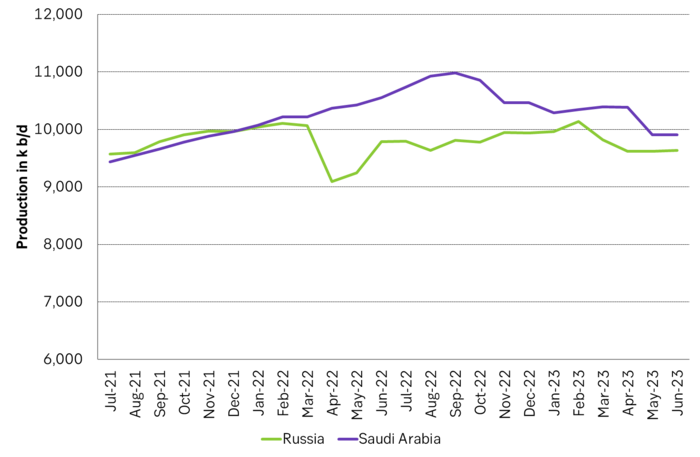
Short specs in Brent and WTI at 205 m barrels as of Tuesday last week. They will likely exit shorts and force the oil price higher.
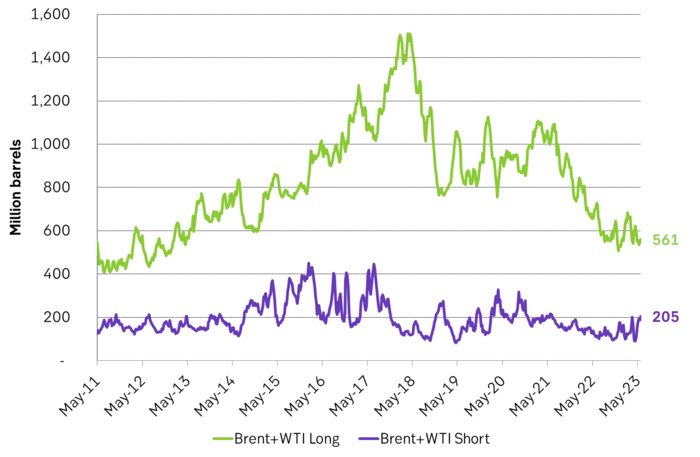
Long vs. Short specs in Brent and WTI at very low level as of Tuesday last week. Will probably bounce back up.
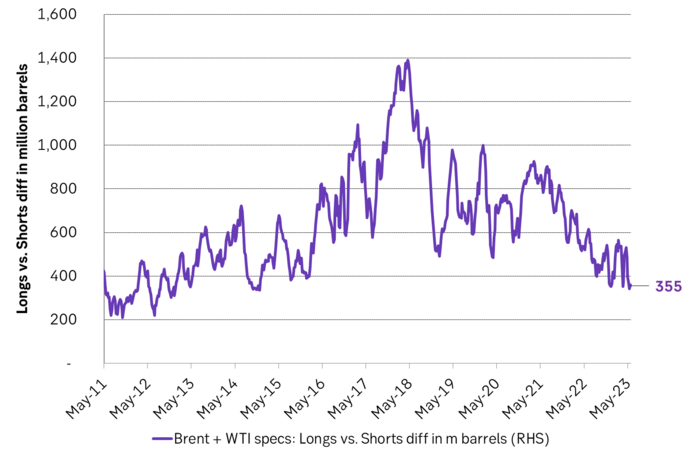
US oil rig count has declined significantly since early Dec-2022 at WTI prices of USD 76/b and Brent of USD 81/b (average since Dec-2022).
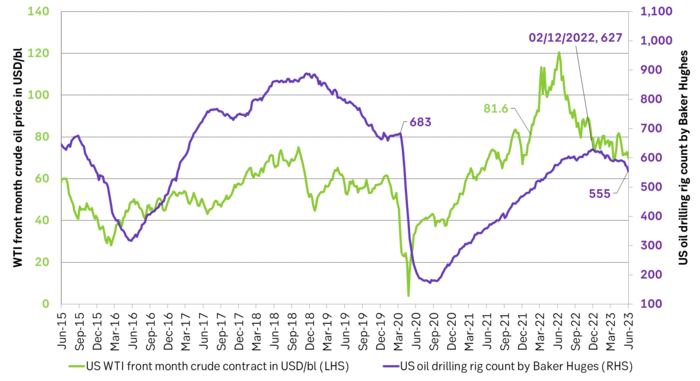
Historical oil prices in nominal and CPI adjusted terms. Recent market memory is USD 57.5/b average from 2015-2019. But that was an extremely bearish period with booming US shale oil production.
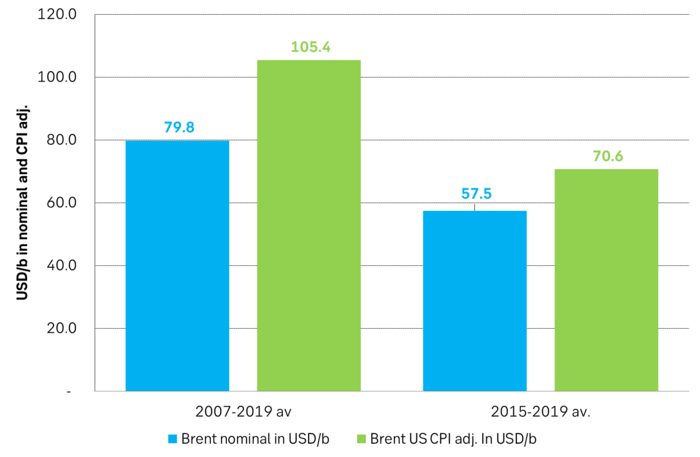
Analys
The Mid-East anchor dragging crude oil lower

When it starts to move lower it moves rather quickly. Gaza, China, IEA. Brent crude is down 2.1% today to $62/b after having traded as high as $66.58/b last Thursday and above $70/b in late September. The sell-off follows the truce/peace in Gaze, a flareup in US-China trade and yet another bearish oil outlook from the IEA.

A lasting peace in Gaze could drive crude oil at sea to onshore stocks. A lasting peace in Gaza would probably calm down the Houthis and thus allow more normal shipments of crude oil to sail through the Suez Canal, the Red Sea and out through the Bab-el-Mandeb Strait. Crude oil at sea has risen from 48 mb in April to now 91 mb versus a pre-Covid normal of about 50-60 mb. The rise to 91 mb is probably the result of crude sailing around Africa to be shot to pieces by the Houthis. If sailings were to normalize through the Suez Canal, then it could free up some 40 mb in transit at sea moving onshore into stocks.
The US-China trade conflict is of course bearish for demand if it continues.
Bearish IEA yet again. Getting closer to 2026. Credibility rises. We expect OPEC to cut end of 2025. The bearish monthly report from the IEA is what it is, but the closer we get to 2026, the more likely the IEA is of being ball-park right in its outlook. In its monthly report today the IEA estimates that the need for crude oil from OPEC in 2026 will be 25.4 mb/d versus production by the group in September of 29.1 mb/d. The group thus needs to do some serious cutting at the end of 2025 if it wants to keep the market balanced and avoid inventories from skyrocketing. Given that IEA is correct that is. We do however expect OPEC to implement cuts to avoid a large increase in inventories in Q1-26. The group will probably revert to cuts either at its early December meeting when they discuss production for January or in early January when they discuss production for February. The oil price will likely head yet lower until the group reverts to cuts.
Dubai: The Mid-East anchor dragging crude oil lower. Surplus emerging in Mid-East pricing. Crude oil prices held surprisingly strong all through the summer. A sign and a key source of that strength came from the strength in the front-end backwardation of the Dubai crude oil curve. It held out strong from mid-June and all until late September with an average 1-3mth time-spread premium of $1.8/b from mid-June to end of September. The 1-3mth time-spreads for Brent and WTI however were in steady deterioration from late June while their flat prices probably were held up by the strength coming from the Persian Gulf. Then in late September the strength in the Dubai curve suddenly collapsed. Since the start of October it has been weaker than both the Brent and the WTI curves. The Dubai 1-3mth time-spread now only stands at $0.25/b. The Middle East is now exporting more as it is producing more and also consuming less following elevated summer crude burn for power (Aircon) etc.
The only bear-element missing is a sudden and solid rise in OECD stocks. The only thing that is missing for the bear-case everyone have been waiting for is a solid, visible rise in OECD stocks in general and US oil stocks specifically. So watch out for US API indications tomorrow and official US oil inventories on Thursday.
No sign of any kind of fire-sale of oil from Saudi Arabia yet. To what we can see, Saudi Arabia is not at all struggling to sell its oil. It only lowered its Official Selling Prices (OSPs) to Asia marginally for November. A surplus market + Saudi determination to sell its oil to the market would normally lead to a sharp lowering of Saudi OSPs to Asia. Not yet at least and not for November.
The 5yr contract close to fixed at $68/b. Of importance with respect to how far down oil can/will go. When the oil market moves into a surplus then the spot price starts to trade in a large discount to the 5yr contract. Typically $10-15/b below the 5yr contract on average in bear-years (2009, 2015, 2016, 2020). But the 5yr contract is usually pulled lower as well thus making this approach a moving target. But the 5yr contract price has now been rock solidly been pegged to $68/b since 2022. And in the 2022 bull-year (Brent spot average $99/b), the 5yr contract only went to $72/b on average. If we assume that the same goes for the downside and that 2026 is a bear-year then the 5yr goes to $64/b while the spot is trading at a $10-15/b discount to that. That would imply an average spot price next year of $49-54/b. But that is if OPEC doesn’t revert to cuts and instead keeps production flowing. We think OPEC(+) will trim/cut production as needed into 2026 to prevent a huge build-up in global oil stocks and a crash in prices. But for now we are still heading lower. Into the $50ies/b.
Analys
More weakness and lower price levels ahead, but the world won’t drown in oil in 2026

Some rebound but not much. Brent crude rebounded 1.5% yesterday to $65.47/b. This morning it is inching 0.2% up to $65.6/b. The lowest close last week was on Thursday at $64.11/b.

The curve structure is almost as week as it was before the weekend. The rebound we now have gotten post the message from OPEC+ over the weekend is to a large degree a rebound along the curve rather than much strengthening at the front-end of the curve. That part of the curve structure is almost as weak as it was last Thursday.
We are still on a weakening path. The message from OPEC+ over the weekend was we are still on a weakening path with rising supply from the group. It is just not as rapidly weakening as was feared ahead of the weekend when a quota hike of 500 kb/d/mth for November was discussed.
The Brent curve is on its way to full contango with Brent dipping into the $50ies/b. Thus the ongoing weakening we have had in the crude curve since the start of the year, and especially since early June, will continue until the Brent crude oil forward curve is in full contango along with visibly rising US and OECD oil inventories. The front-month Brent contract will then flip down towards the $60/b-line and below into the $50ies/b.
At what point will OPEC+ turn to cuts? The big question then becomes: When will OPEC+ turn around to make some cuts? At what (price) point will they choose to stabilize the market? Because for sure they will. Higher oil inventories, some more shedding of drilling rigs in US shale and Brent into the 50ies somewhere is probably where the group will step in.
There is nothing we have seen from the group so far which indicates that they will close their eyes, let the world drown in oil and the oil price crash to $40/b or below.
The message from OPEC+ is also about balance and stability. The world won’t drown in oil in 2026. The message from the group as far as we manage to interpret it is twofold: 1) Taking back market share which requires a lower price for non-OPEC+ to back off a bit, and 2) Oil market stability and balance. It is not just about 1. Thus fretting about how we are all going to drown in oil in 2026 is totally off the mark by just focusing on point 1.
When to buy cal 2026? Before Christmas when Brent hits $55/b and before OPEC+ holds its last meeting of the year which is likely to be in early December.
Brent crude oil prices have rebounded a bit along the forward curve. Not much strengthening in the structure of the curve. The front-end backwardation is not much stronger today than on its weakest level so far this year which was on Thursday last week.

The front-end backwardation fell to its weakest level so far this year on Thursday last week. A slight pickup yesterday and today, but still very close to the weakest year to date. More oil from OPEC+ in the coming months and softer demand and rising inventories. We are heading for yet softer levels.

Analys
A sharp weakening at the core of the oil market: The Dubai curve

Down to the lowest since early May. Brent crude has fallen sharply the latest four days. It closed at USD 64.11/b yesterday which is the lowest since early May. It is staging a 1.3% rebound this morning along with gains in both equities and industrial metals with an added touch of support from a softer USD on top.

What stands out the most to us this week is the collapse in the Dubai one to three months time-spread.
Dubai is medium sour crude. OPEC+ is in general medium sour crude production. Asian refineries are predominantly designed to process medium sour crude. So Dubai is the real measure of the balance between OPEC+ holding back or not versus Asian oil demand for consumption and stock building.
A sharp weakening of the front-end of the Dubai curve. The front-end of the Dubai crude curve has been holding out very solidly throughout this summer while the front-end of the Brent and WTI curves have been steadily softening. But the strength in the Dubai curve in our view was carrying the crude oil market in general. A source of strength in the crude oil market. The core of the strength.
The now finally sharp decline of the front-end of the Dubai crude curve is thus a strong shift. Weakness in the Dubai crude marker is weakness in the core of the oil market. The core which has helped to hold the oil market elevated.
Facts supports the weakening. Add in facts of Iraq lifting production from Kurdistan through Turkey. Saudi Arabia lifting production to 10 mb/d in September (normal production level) and lifting exports as well as domestic demand for oil for power for air con is fading along with summer heat. Add also in counter seasonal rise in US crude and product stocks last week. US oil stocks usually decline by 1.3 mb/week this time of year. Last week they instead rose 6.4 mb/week (+7.2 mb if including SPR). Total US commercial oil stocks are now only 2.1 mb below the 2015-19 seasonal average. US oil stocks normally decline from now to Christmas. If they instead continue to rise, then it will be strongly counter seasonal rise and will create a very strong bearish pressure on oil prices.
Will OPEC+ lift its voluntary quotas by zero, 137 kb/d, 500 kb/d or 1.5 mb/d? On Sunday of course OPEC+ will decide on how much to unwind of the remaining 1.5 mb/d of voluntary quotas for November. Will it be 137 kb/d yet again as for October? Will it be 500 kb/d as was talked about earlier this week? Or will it be a full unwind in one go of 1.5 mb/d? We think most likely now it will be at least 500 kb/d and possibly a full unwind. We discussed this in a not earlier this week: ”500 kb/d of voluntary quotas in October. But a full unwind of 1.5 mb/d”
The strength in the front-end of the Dubai curve held out through summer while Brent and WTI curve structures weakened steadily. That core strength helped to keep flat crude oil prices elevated close to the 70-line. Now also the Dubai curve has given in.

Brent crude oil forward curves

Total US commercial stocks now close to normal. Counter seasonal rise last week. Rest of year?

Total US crude and product stocks on a steady trend higher.

-

 Nyheter4 veckor sedan
Nyheter4 veckor sedanTyskland har så höga elpriser att företag inte har råd att använda elektricitet
-

 Nyheter3 veckor sedan
Nyheter3 veckor sedanOPEC+ missar produktionsmål, stöder oljepriserna
-

 Nyheter3 veckor sedan
Nyheter3 veckor sedanEtt samtal om guld, olja, fjärrvärme och förnybar energi
-

 Nyheter2 veckor sedan
Nyheter2 veckor sedanGuld nära 4000 USD och silver 50 USD, därför kan de fortsätta stiga
-

 Analys3 veckor sedan
Analys3 veckor sedanAre Ukraine’s attacks on Russian energy infrastructure working?
-

 Nyheter1 vecka sedan
Nyheter1 vecka sedanGoldman Sachs höjer prognosen för guld, tror priset når 4900 USD
-

 Nyheter2 veckor sedan
Nyheter2 veckor sedanBlykalla och amerikanska Oklo inleder ett samarbete
-

 Nyheter3 veckor sedan
Nyheter3 veckor sedanGuldpriset uppe på nya höjder, nu 3750 USD









